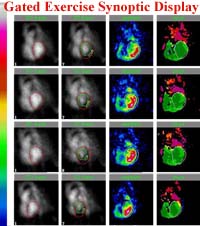
Family Of Digital Nuclear Camera's
|
|
|
Rectangular
Detector
|
|

|
|
Starting
at $180,000 |
|
Rectangular
Field
The NuCamma
 is
the first of the second generation, all digital gamma
cameras. It combines the advantages of signal
processing which digitizes the photomultiplier signals
directly, with the most recent developments in computer
hardware and operating system software to provide a new
standard of performance and economy.
is
the first of the second generation, all digital gamma
cameras. It combines the advantages of signal
processing which digitizes the photomultiplier signals
directly, with the most recent developments in computer
hardware and operating system software to provide a new
standard of performance and economy.
The NuCamma family of cameras
combine all the system electronics, including the computer
processing and analysis software, in the detector head.
This "All in the Head
family of cameras
combine all the system electronics, including the computer
processing and analysis software, in the detector head.
This "All in the Head "
approach refers not only to the unique combination of
hardware and software in the detector head, but also to the
concept that the clinical performance of a camera is
dependent on the performance of the detector head. "
approach refers not only to the unique combination of
hardware and software in the detector head, but also to the
concept that the clinical performance of a camera is
dependent on the performance of the detector head. |
|
|
|

|
|
Starting
at $160,000 |
|
Cardiac
The NuCamma
 is
the first of the second generation, all digital gamma
cameras. It combines the advantages of signal
processing which digitizes the photomultiplier signals
directly, with the most recent developments in computer
hardware and operating system software to provide a new
standard of performance and economy.
is
the first of the second generation, all digital gamma
cameras. It combines the advantages of signal
processing which digitizes the photomultiplier signals
directly, with the most recent developments in computer
hardware and operating system software to provide a new
standard of performance and economy.
The NuCamma family of cameras
combine all the system electronics, including the computer
processing and analysis software, in the detector head.
This "All in the Head
family of cameras
combine all the system electronics, including the computer
processing and analysis software, in the detector head.
This "All in the Head "
approach refers not only to the unique combination of
hardware and software in the detector head, but also to the
concept that the clinical performance of a camera is
dependent on the performance of the detector head. "
approach refers not only to the unique combination of
hardware and software in the detector head, but also to the
concept that the clinical performance of a camera is
dependent on the performance of the detector head. |
|

Starting
at $242,000
|
The Bi9O is a gamma camera
system optimized for high performance cardiac studies. The
camera performs rest and stress gated SPECT and bi-plane
gated planar studies. The resolution, sensitivity and image
quality of the Bi90 are superior to variable geometry camera
systems. The fixed 90 degree geometry of the Bi90 has
several advantages. The detector geometry is precisely what
is required for cardiology because the detector heads may be
placed adjacent to each |
|
| other without shielding. This
ensures that the heart is completely within the field of view
without placing the detectors at a less than optimal angle,
which is often required by variable geometry detector systems.
With the Bi90 the center of rotation accuracy and
reproducibility is of a much higher order. With variable
geometry cameras, the mechanical complexity of variable geometry
detector systems contribute to an imprecision that is
demonstrated by their center of rotation specifications. The
Bi90 demonstrates higher resolution, higher data integrity and
artifact free imaging through a center of rotation better than
1/2 mm The detectors of the Bi9O have the highest spatial and
energy resolution available of any camera. This markedly
improves thallium cardiac images at 8OKeV and assists in a more
confident clinical diagnosis. The NEMA intrinsic spatial
resolution is 3 mm FWHM while intrinsic energy resolution is
8.8% at Tc99m, both of which are the best in the industry.
Access to the front of the gantry is clear and open allowing for
the use of exercise bicycles or treadmills for bi-plane gated
studies or for first pass studies. The detector head can be set
at 0 degrees, 10 degrees, 45 degrees, and 90 degrees allowing
studies not possible with other systems. |
|

|
Collimators
IS2
has developed a range of optimized collimators for its
scintillation cameras. Optimization of collimators
ensures that the clinical performance is as high as
theoretically possible.
Collimators
function at specific energy ranges, therefore, the amount of
lead or collimator material has to be appropriate for the
energy being imaged. For optimization the collimators
have to weigh differing amounts and therefore the camera has
to be able to accommodate differing weights of collimators.
The best
clinical performance is obtained by the balance of
sensitivity and penetration of the collimator walls by the
given gamma ray, according to energy. This process
gives not only resolution in the images, but also contract,
essential for the clinician to be able to distinguish and
visualize the objects with the resolution provided by the
collimators.
|
| i.Station
The
i.Station
completes the image acquisition software in the NuCammas and
provides the display analysis and patient data filing
functions of the system. The system is very versatile
and practical to use. It has a unique operator
interface based on flow charts rather than icons and pull
down menus.

The
system is fully networked as standard and one
i.Station can
support many cameras, telemedicine, remote access and image
fusion.
|

|
Home Page
|